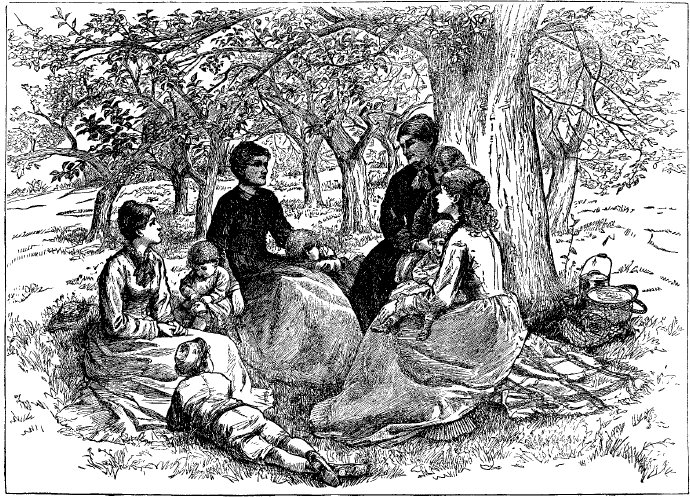Indeed, even the demise of Beth can be seen not as a succumbing to death, but as a transcendent triumph over it. Because of the quiet courage and grace with which she faces the end, her passing feels less like a defeat than an apotheosis.
Two aspects of the happy ending of Little Women can never be emphasized enough. The first is Alcott’s insistence that all young women’s stories need not end the same. Through the diverse destinies of Meg, Jo, and Amy, Alcott stoutly asserts that there are a variety of happy endings toward which a growing girl might aspire. In contrast to Meg, who finds contentment as a wife and mother, Jo discovers the best part of herself by founding the progressive school Plumfield. Amy, happily allied with Laurie, pursues a life enlivened by art and philanthropy. Indeed, Alcott would have scattered her happy endings across an even wider range of outcomes if she had had her wish. Having conceived for Jo a rewarding life as a literary spinster, she relented only when her publisher, Roberts Brothers, persuaded her that marrying Jo off was the only commercially viable choice.
The second point is that not one of the four March sisters finds happiness by getting what she initially wanted. Near the midpoint of Part First, in a chapter called “Castles in the Air,” each of the girls lays out the future of her dreams. Meg, the materialist, covets “a lovely house, full of all sorts of luxurious things; nice food, pretty clothes, handsome furniture, pleasant people, and heaps of money.” Bookworm Jo aspires to “a stable full of Arabian steeds, rooms piled with books,” and a magic inkstand to bless her writings with literary fame. Beth modestly asks only “to stay at home safe with father and mother” and that “we all may keep well, and be together.” Amy, the budding aesthete, wants to “go to Rome, and do fine pictures, and be the best artist in the whole world.” At the novel’s end, not one of the girls’ wishes is fulfilled. Even Beth’s poignantly humble prayer for health and togetherness is cruelly denied. If happiness means nothing more than getting what one wants, the world of Little Women seems less one of dreams come true than one of thwarted youthful desires. But Alcott had a more mature idea of happiness. The March girls do not cry because their childish fantasies have been denied. Instead, they acquire the wisdom to accept fate when necessary and the courage to build less selfish dreams when possible. They find happiness not in narrow self-gratification, but in self-improvement and service to others.
Not only do the March sisters learn to be realists, but the landscape in which they live and grow is, unlike that of a multitude of children’s classics, uncompromisingly real. Although Jo and her sisters would gladly escape from their poverty and their anxiousness over the fate of their father, Alcott conjures no Oz, no Neverland, no Narnia for them to flee to. One of the greatest strengths of Little Women is that it is not a story about running away. Many books that worthily bear the mantle of “children’s classic”—Huckleberry Finn and Peter Pan spring readily to mind—are founded on fantasies of escape and even the possibility of eternal childhood. The marvelous boys at the center of those books will take a stand if they have to, and they have lessons aplenty to teach about the nature of courage. Still, their more frequent preference is for flight—away from responsibility and unpleasantness, even away from mortality itself. We love them, at least in part, for the genius and even the miraculous quality of their evasions. But, whereas many of her successors in children’s fiction would offer to solve their heroes’ problems by having them escape into a realm of magic and fantasy, Alcott preserves a firm barrier between imagination and fact. We love the March sisters because they stand their ground. When the March sisters do attempt to escape, as they do when they stage their plays, read their books, play their music, or simply drift off into pipe dreams of the future, they remain quite clear as to what’s real and what isn’t. Still, imagined reality plays an extremely prominent role in Little Women, and a key to understanding the progress of the March sisters from childhood to adulthood lies in an appreciation of how the characters’ own engagement with literary fiction informs their mental and emotional growth. To a very large extent, the March sisters are who they are because of what they read.

One is hard-pressed to think of a work of children’s fiction that contains a greater range and quantity of literary allusions than Little Women. To fully appreciate the literary context into which Alcott inserts the March family, one would require a knowledge of at least five dozen authors to whom Alcott either alludes or openly refers, as well as a relatively powerful command of the King James Bible. Other protagonists in classic novels for and about children often exist in a world disconnected not only from literature, but even from literacy.
1 comment